SQUID GAME - HUNGER GAMES – DYSTOPIAN WORLDS BASED ON BOFILL’S - LES ESPACES D’ABRAXAS and LA MURALLA ROJA
Les Espaces d’Abraxas, (Abraxas Spaces) was conceived as an ‘inhabited monument’. It was the architect Ricardo Bofill’s attempt to uplift the residents of the social housing development by providing a classical, theatrical environment normally reserved for the upper classes.
The monumental complex is an intriguing urban landmark on the outskirts of Paris. At the entrance to the new town of Marne-la-Vallée, it is an iconic example of postmodern architecture, built between 1978 and 1983, to address the housing shortage in the Paris suburbs. It was designed as a postmodern alternative to the typical utilitarian social housing blocks of the era.
The complex contains five hundred and ninety-one apartment and covers an area of just under two acres. Two-thirds of the flats were designated as social housing, while the rest were to be privately owned.
The complex consists of three monumental buildings: one circular, one elliptical and the other shaped like an amphitheatre - Le Palacio, Le Théâtre, and L ’Arc - arranged around a large central plaza designed to evoke ancient Greek theatres. Bofill created an urban space reminiscent of a stage set or a grand plaza.
The semi-circular Le Théâtre encloses and defines the communal outdoor plaza.
Dynamic and theatrical, the reflective glass columns shift with the light.
The outside of Le Théâtre
L’Arc
The smallest building, L’Arc,(the Arch), is the heart of the composition. An interesting take on the triumphal arch, the Arch acts as a symbolic ‘stage’ or focal point of the complex. Traditionally triumphal arches were not functional, but Bofill turned a historical symbol into an inhabited space, with nine floors and twenty apartments.
THE CHALLENGE OF LIVING IN LES ESPACES D’ABRAXAS
The unique blend of classicism and brutalism of Les Espaces d’Abraxas give the buildings a sense of grandiosity, but the residents are dwarfed by the monumental scale of the fortress-like buildings.
A resident walks along a monumental inside passageway
Surrounded by an ocean of concrete, the inhabitants found the building’s harsh atmosphere oppressive and isolating. Its cramped interiors and labyrinthine corridors made it like a prison. The lack of green spaces and long corridors encouraged crime and made the complex unsafe to live in.
The building’s prefabricated concrete façades deteriorated over time, and, with crime adding to the grim atmosphere, the nicknames ‘Alcatraz’ or ‘Gotham City’ soon caught on.
In the early 2000s there were plans to demolish the buildings. But despite its flaws, the residents were attached to their homes and resisted the demolition. The building is presently being rehabilitated by the French local government.
LES ESPACES D’ABRAXAS – A PERFECT DYSTOPIAN FILM SET
The bold, futuristic, almost surreal, appearance of Les Espaces d’Abraxas has become a favourite location for filmmakers. The qualities that made it a difficult environment to live in were the very qualities required to represent a dystopian, futuristic world.
Les Espaces d’Abraxas has featured in several high-profile dystopian and science fiction films. Used as a backdrop for societies where individuals feel controlled and lost, overwhelmed by the system or by the architecture itself.
The monolithic Le Palacio
THE FILM BRAZIL
The building first achieved notoriety as a backdrop for a dystopian, science-fiction, black comedy: Terry Gilliam’s cult classic Brazil. The story follows Sam Lowry, a low-level bureaucrat who is trying to find a woman who appears in his dreams while he is working in a mind-numbing job. During his search, Sam becomes entangled in a surreal, nightmarish world of malfunctioning technology and oppressive bureaucracy. Filmed in 1985, Les Espaces d’Abraxas was used to represent a bureaucratic, nightmarish future.
Brazil is renowned for its satirical take on technocracy, bureaucracy, and hyper-surveillance. It has drawn comparisons to George Orwell’s Nineteen Eighty-Four and is often described as ‘Kafkaesque’ and absurdist.
THE FILM BIG BUG
Big Bug also filmed in Les Espaces d’Abraxas, is a French science fiction black comedy, directed by Jean-Pierre Jeunet in 2022.
Set in the world of 2045, where communities have robotic helpers, a group of suburbanites are locked in for their own protection by their household robots, while a rogue, sentient AI android uprising takes place outside. It offers a satirical look at a future dominated by AI, combining comedy with a cautionary tale about technology’s potential to control and isolate humanity. The director made full use of the surreal, futuristic setting and imposing spaces of Les Espaces d’Abraxas.
THE FILM THE HUNGER GAMES
In the dystopian The Hunger Games: Mockingjay – Part 2, Les Espaces d’Abraxas served as the Capitol, the authoritarian heart of the world of Panem. Based on Suzanne Collins’ book The Hunger Games, the film, directed by Francis Lawrence in 2015, is a powerful critique of authoritarianism and social injustice.
The Hunger Games explores themes of oppression, survival, loss of identity, fear, and resistance against tyranny. Panem is a classic dystopia where a privileged elite exploits and controls the masses through fear, spectacle, and inequality.
The buildings of Les Espaces d’Abraxas enhance the film’s themes of control and dehumanization. They are a perfect metaphor for social inequality and the disparity between the privileged, in control, and the marginalized.
A massive, brutalist, section of Le Palacio.
THE HUNGER GAMES PLOT SUMMARY
The following summary of The Hunger Games perfectly describes the dystopian world of Les Espaces d’Abraxas:
The inhabitants of the Capitol enjoy a life of luxury, peace, and advanced technology, while the districts suffer from poverty, hunger, and harsh living conditions. The home of protagonist Katniss Everdeen, District 12, is impoverished and plagued by starvation.
The Capitol maintains power through oppressive surveillance, brutal law enforcement by Peacekeepers, and strict control over the districts. Fear and violence are used to suppress dissent and prevent rebellion
As a punishment for an uprising in the ‘Dark Days’, the districts must send one boy and one girl, called tributes, every year, to fight to the death in the televised Hunger Games.
This spectacle serves as entertainment for the Capitol’s citizens and is a stark reminder of the Capitol’s dominance and cruelty. The media, controls information, glorifies the Games, and manipulates public opinion, to ensure the population remains submissive and distracted.
To prevent unity and further rebellion, the districts are not allowed contact. Forced into specific jobs, with limited social mobility, the people are resentful.
In the last of the three films, Mockingjay – Part 2, Katniss Everdeen leads a rebellion to liberate Panem and remove the tyrannical President Snow.
Catniss and her squad in Les Espaces d’Abraxas
A cameraman filming a scene from The Hunger Games, in Le Théâtre of Les Espaces d’Abraxas
THE ROLE OF LES ESPACES D’ABRAXAS IN THE HUNGER GAMES
The buildings of Les Espaces d’Abraxas are the perfect cinematic backdrop for the dystopian Capitol of Panem. The scale and monumentality, the solid stone facades, the sense of grandeur and power, and the labyrinthine passages, all contribute to the film’s oppressive atmosphere.
With a layout that is easy to booby-trap, the Director and his assistant immediately saw the building’s potential for one of the film’s most crucial scenes: the ambush of Katniss and her squad as they advance through the Capitol. A wave of almost sentient black tar oozes down the streets, moving quickly, suffocating, and drowning anything in its path. The layout of the Théâtre lent itself perfectly to the scene.
In a scene from Mockingjay Part 2, the Peacekeepers, in white armour, arrive by truck to pursue the rebels.
The use of architecture as a powerful tool for storytelling, has had a huge cultural impact. The appearance of Les Espaces d’Abraxas in major films has cemented its place as a cultural and cinematic landmark among film fans and members of the younger generation.
BOFILL AND THE SQUID GAME SERIES
Squid Game is another film in which the architecture is used as a powerful tool for storytelling. The Art Director has combined imagery associated with the innocence of childhood, with a story about money, greed, violence and death.
The most striking architectural space in Squid Game is the area the competitors are forced to walk through to access the arenas. The iconic scene with its towering labyrinth of maze-like staircases was inspired by M.C. Escher’s famous Relativity lithograph, and the shapes and bold colours of Ricardo Bofill’s La Muralla Roja.
Each of the show’s key spaces, has a fascinating backdrop as the story quickly evolves from tense to terrifying. The scenes conjures feelings of unease. Viewers feel compelled to continue watching, despite their discomfort.
The designers of Squid Game borrowed heavily from Ricardo Bofill’s La Muralla Roja
The dystopian South Korean television series, Squid Game, made its debut on Netflix, in September 2021.
Two months later, the show had Netflix’s highest viewership ever, with over 1.65 billion hours watched in its first 28 days. The series received six Primetime Emmy Awards and one Golden Globe. Its success led to a second and third season.
Squid Game is a political satire on the corrupting influence of capitalism. Hwang Dong-hyuk, conceived of the idea because of his own financial struggles and South Korea’s class disparity.
The series revolves around a secret contest where 456 players, all in deep financial trouble, risk their lives to play a series of deadly children's games, hoping to win a prize of thirty-nine million US dollars.
Besides its twisted plot and the compelling cast of characters, the surreal architecture presented throughout the show plays a key role in scaring the viewers as much as the contestants.
The staircase scene reflects order, discipline, and silent terror. The stark contrast between the playful candy colours and the sinister gameplay are jarring. The disconnect increases the disquiet of both players and viewers.
Squid Game is a compelling case study in how architecture can evoke a sense of alienation and dystopia while eliciting a wide range of emotions, from unease to terror.
VIDEO GAMES AND CULTURAL REFERENCES
Ricardo Bofill’s architectural style has also had an influence on video games. The recently developed puzzle game, Monument Valley, has been acclaimed globally. Its surreal, visually stunning graphics, bear a strong resemblance and a similar atmosphere to Ricardo Bofill’s La Muralla Roja. The game is characterized by Escher-like optical illusions, while its geometric shapes, volumes and colours are as surreal as Bofill’s sculptural buildings.
https://www.monumentvalleygame.com/mv1
La Muralla Roja, Bofill’s modern reinterpretation of a traditional North African kasbah, rejected the monotony that prevailed at the time.
Bofill chose intense reds, pinks, blues, and violets for the walls of La Muralla Roja. A striking decision, at a time when the dominant architectural trend was for neutral, muted colours. The external walls were painted in reds and pinks, the internal walls in varying shades of blue.
Bofill’s revolutionary use of bold colours created a visual language, still used today.
The way game designers manipulate space, depth, and atmosphere to create immersive environments in their video games has also been notably influenced by Bofill’s architectural style.
Bofill’s legacy
Many of Bofill’s buildings like Walden 7, Les Espaces d’Abraxas and La Muralla Roja have become cultural icons. They are frequently featured in photography, films, music videos and video games, influencing contemporary visual culture and inspiring new generations of architects and designers, artists, photographers, and influencers.
Bofill’s bold colours, his playfulness, and his powerful geometry appeal to young people. His originality has gained him many Gen Z followers and created an enduring legacy.
(Gen Z - the generation born in the 1990s).
___________________________________
Some photographs by Laurent Kronental and Kevin of MRC Travel
___________________________________
To receive new articles as they are published, please subscribe to my free Substack elysoun.substack.com.
Feel free to share the link and invite friends and family to subscribe. Please click on the heart to show you have read and enjoyed my article. Comments are also welcome.
Thank you for reading!







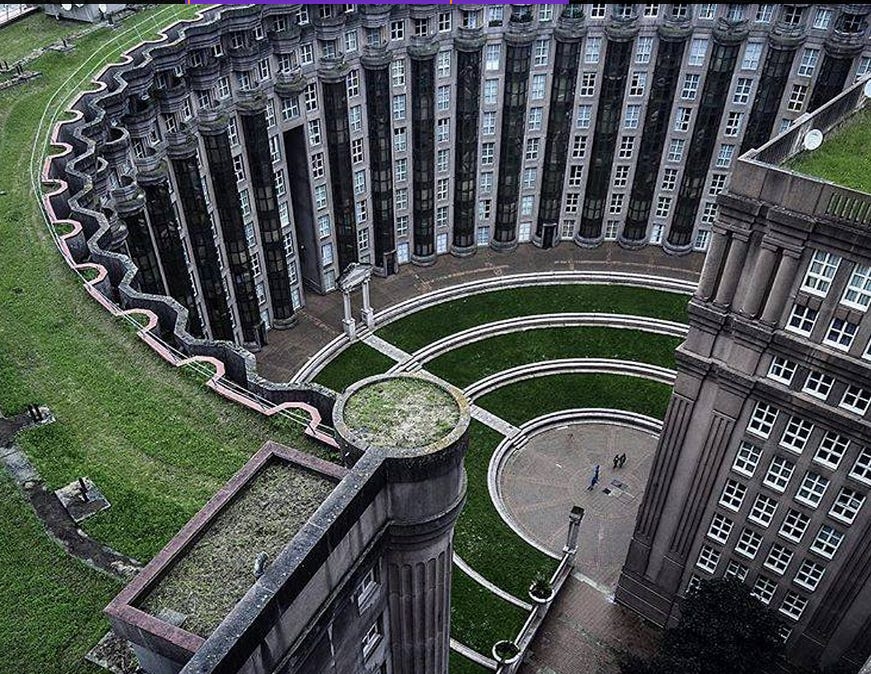

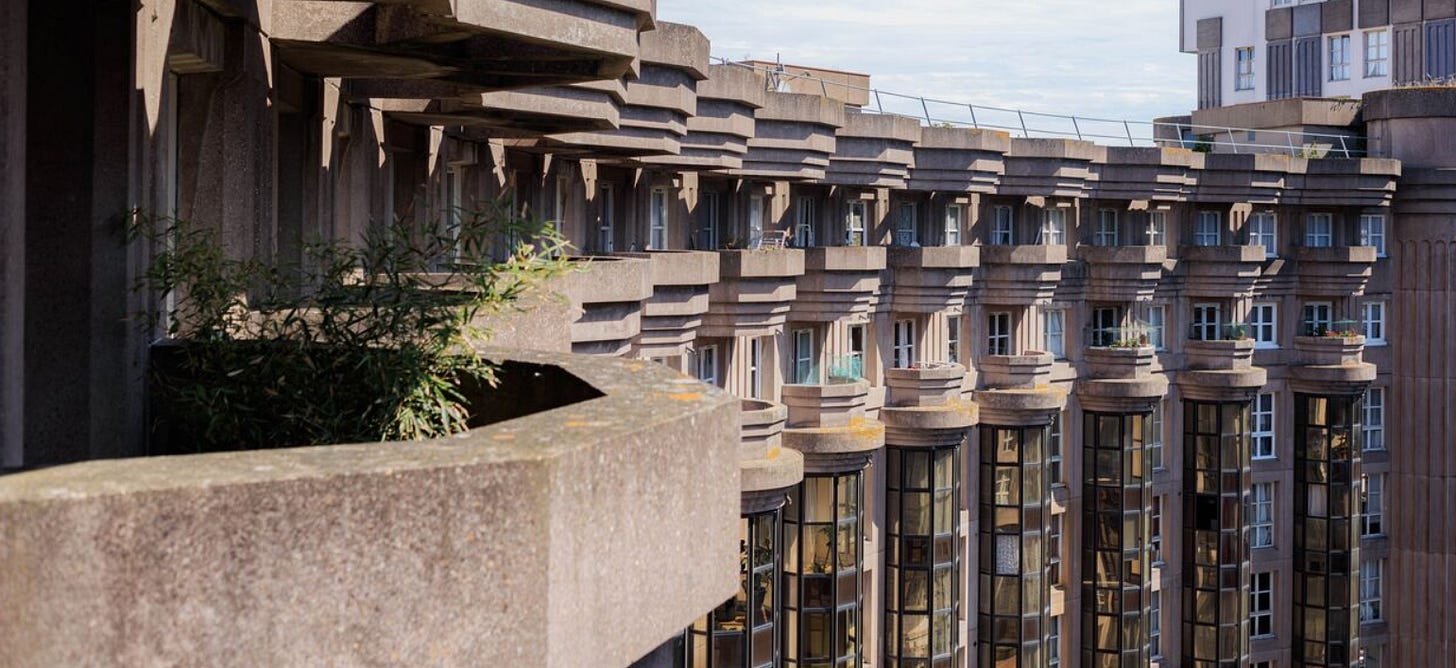

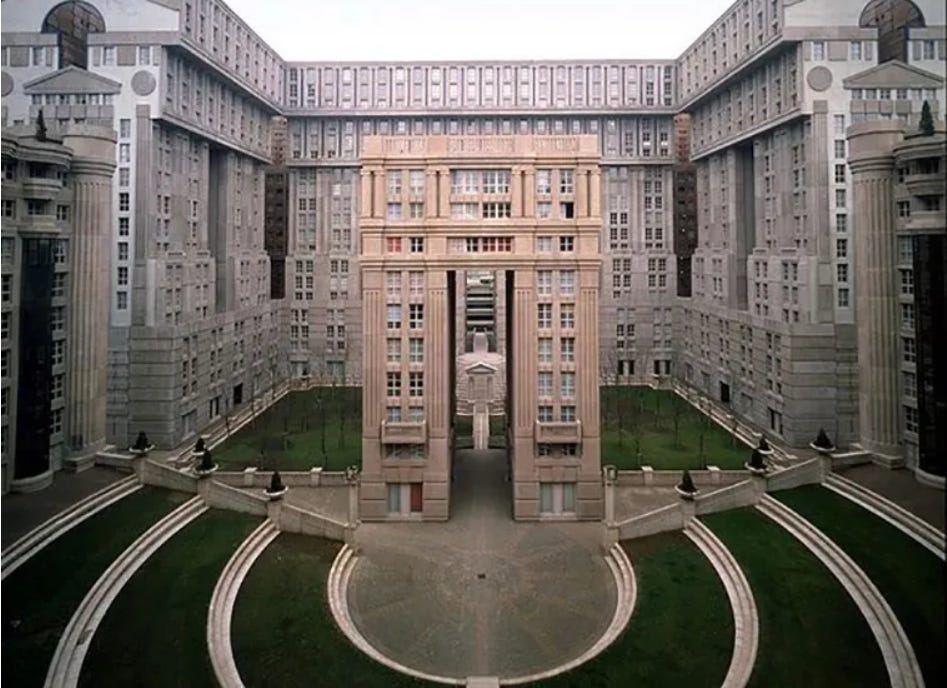


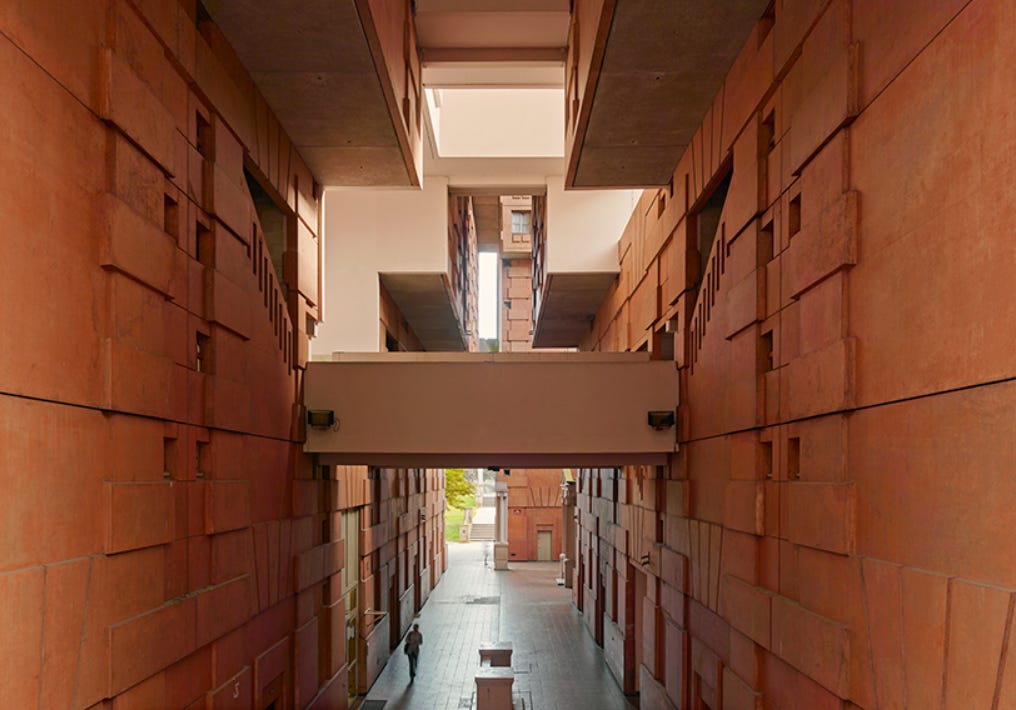


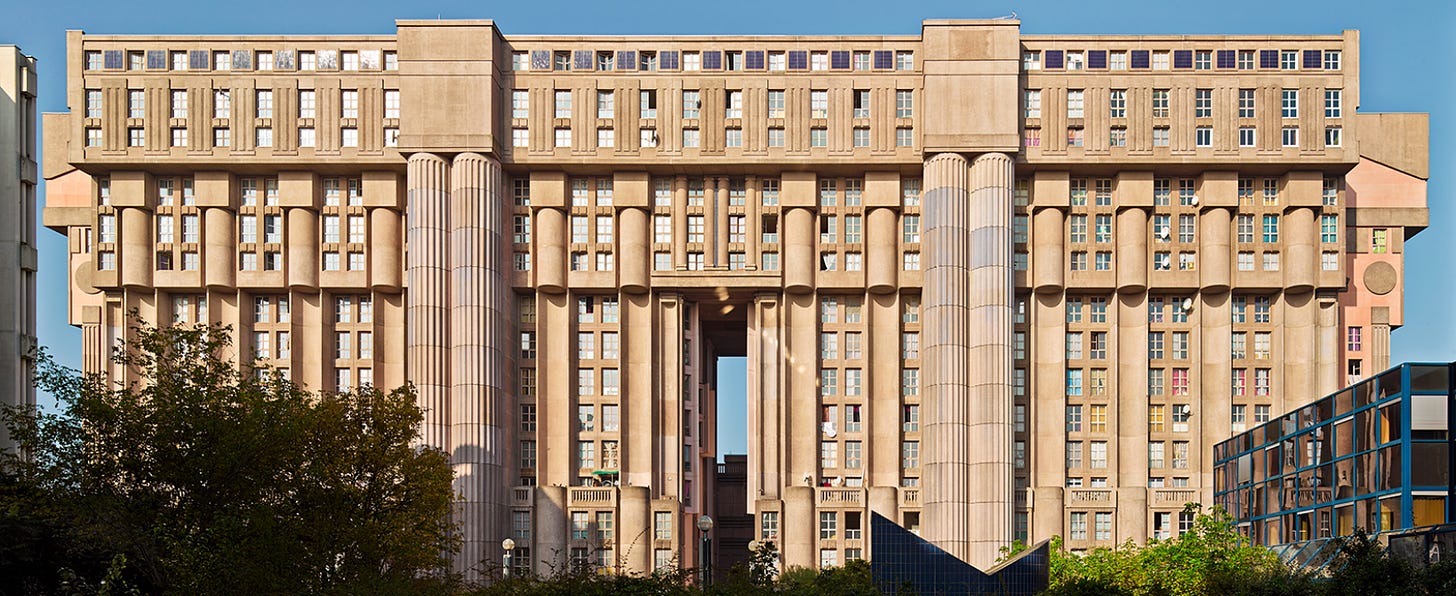












I once lamented to an architect the starkly dissociative layout of South Africa's RDP housing; he retorted that there was no relation between architecture and community well-being. Your article indicates the opposite; fascinating look at articulations between monumentalism and misery, Brutalism and brutality. Similarly, didn't Johannesburg's Ponte Building feature in the dystopian film District 9?
Brilliant writing about a brutal world and some buildings which embody it. The reality of these blunt wedges is thoroughly explored and explained in this piece. The illustrations, particularly the vividly coloured interior stairwells, make me glad I live a third of the world away. This subject choice is so far removed from the arabesque lyricism of La Sagrada Familia that is is fascinating to consider how the same Catalan mind spirit can produce such extremes of visual poetry.